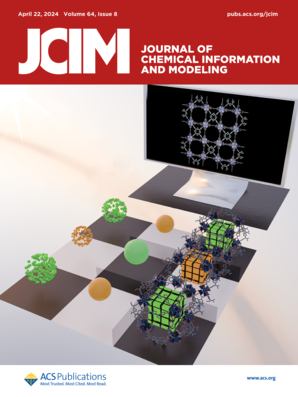点突变对hCFTR NBD1结构域热稳定性的影响。
IF 5.3
2区 化学
Q1 CHEMISTRY, MEDICINAL
引用次数: 0
摘要
囊性纤维化(CF)是由囊性纤维化跨膜传导调节因子(CFTR)氯离子通道突变引起的常染色体隐性遗传病。CFTR的第一个核苷酸结合结构域(NBD1)被认为是cf引起突变的热点,其中一些突变损害了该结构域的热稳定性及其与其他结构域的相互作用。这些突变发挥其有害作用的机制在这种复杂疾病的基础研究以及突变特异性治疗的发展中是重要的。考虑到这一点,我们研究了两个ii类,严重的,导致cf的突变,L467P和A559T,已知分别在19.3°C和10.7°C破坏结构域,并导致错误折叠,无功能的CFTR,通过在410 K高温下对L467P- nbd1和A559T- nbd1构建体进行微秒长分子动力学(MD)模拟。为了进行比较,对野生型(WT)构建体以及6SS-NBD1和2PT/M470V-NBD1构建体也进行了类似的模拟,这两种构建体都携带稳定突变,分别使结构域稳定17.5°C和8.2°C。使用多个指标分析得到的轨迹,结果表明实验ΔTm值与模拟结果、多个实验观测值与先前建模工作的结果之间具有良好的相关性。具体来说,我们的分析指出NBD1内的特定区域受到L467P和A559T突变的严重影响,因此可能在其发病机制中发挥一定作用。许多这些区域也被认为对全长CFTR的正确折叠和功能很重要。利用DSSP元件的时间依赖分配,我们还发现两个突变体遵循不同的分解途径,L467P-NBD1从位于f1样atp结合核心亚域的464-471区域开始,并继续在ABCα亚域的550-562和514-523区域开始,而A559T-NBD1同时从550-562和514-523区域开始。我们认为,这项工作中的分析可能为开发L467P和a559t特异性CF疗法铺平道路,并扩展到CF和其他涉及其他蛋白质nbd突变的其他疾病的其他突变特异性疗法。本文章由计算机程序翻译,如有差异,请以英文原文为准。
Effects of Point Mutations on the Thermal Stability of the NBD1 Domain of hCFTR.
Cystic fibrosis (CF) is an autosomal recessive genetic disease caused by mutations in the cystic fibrosis transmembrane conductance regulator (CFTR) chloride channel. The first nucleotide-binding domain (NBD1) of the CFTR is considered to be a hotspot for CF-causing mutations, and some of these mutations compromise the domain's thermal stability as well as its interactions with other domains. The mechanisms by which such mutations exert their deleterious effects are important in the basic research of this complex disease as well as for the development of mutation-specific therapies. With this in mind, we studied two class-II, severe, CF-causing mutations, L467P and A559T, known to destabilize the domain by 19.3 and 10.7 °C, respectively, and to lead to a misfolded, nonfunctioning CFTR, by conducting microsecond-long molecular dynamics (MD) simulations at an elevated temperature of 410 K on L467P-NBD1 and A559T-NBD1 constructs. For comparison, similar simulations were also performed on the wild-type (WT) construct and on the 6SS-NBD1 and 2PT/M470V-NBD1 constructs, both bearing sets of stabilizing mutations that stabilize the domain by 17.5 and 8.2 °C, respectively. The resulting trajectories were analyzed using multiple metrics, leading to a good correlation between the experimental ΔTm values and the results of the simulations, as well as multiple experimental observations and results of previous modeling efforts. Specifically, our analyses point to specific regions within NBD1 that are substantially affected by the L467P and A559T mutations and, therefore, may play some role in their pathogenesis. Many of these regions are also known to be important for the proper folding and function of the full-length CFTR. Using time-dependent assignment of DSSP elements, we also found that the two mutants follow different disintegration pathways, that of L467P-NBD1 starting in region 464-471 which resides within the F1-like ATP-binding core subdomain and continues in regions 550-562 and 514-523 within the ABCα subdomain whereas that of A559T-NBD1 simultaneously starting at the 550-562 and 514-523 regions. We propose that the analyses presented in this work may pave the way toward the development of L467P and A559T-specific CF therapies and by extension to other mutation-specific therapies for CF and for other diseases involving mutations in NBDs of other proteins.
求助全文
通过发布文献求助,成功后即可免费获取论文全文。
去求助
来源期刊
CiteScore
9.80
自引率
10.70%
发文量
529
审稿时长
1.4 months
期刊介绍:
The Journal of Chemical Information and Modeling publishes papers reporting new methodology and/or important applications in the fields of chemical informatics and molecular modeling. Specific topics include the representation and computer-based searching of chemical databases, molecular modeling, computer-aided molecular design of new materials, catalysts, or ligands, development of new computational methods or efficient algorithms for chemical software, and biopharmaceutical chemistry including analyses of biological activity and other issues related to drug discovery.
Astute chemists, computer scientists, and information specialists look to this monthly’s insightful research studies, programming innovations, and software reviews to keep current with advances in this integral, multidisciplinary field.
As a subscriber you’ll stay abreast of database search systems, use of graph theory in chemical problems, substructure search systems, pattern recognition and clustering, analysis of chemical and physical data, molecular modeling, graphics and natural language interfaces, bibliometric and citation analysis, and synthesis design and reactions databases.

 求助内容:
求助内容: 应助结果提醒方式:
应助结果提醒方式:


